Made with just 4 simple ingredients, this Swiss Meringue Buttercream recipe is perfect for a light, creamy frosting that isn't quite as sweet as its American buttercream cousin. The fluffy, delicious frosting is perfect for decorating cakes and cupcakes or spreading on cookies or even enjoyed as a fruit dip!
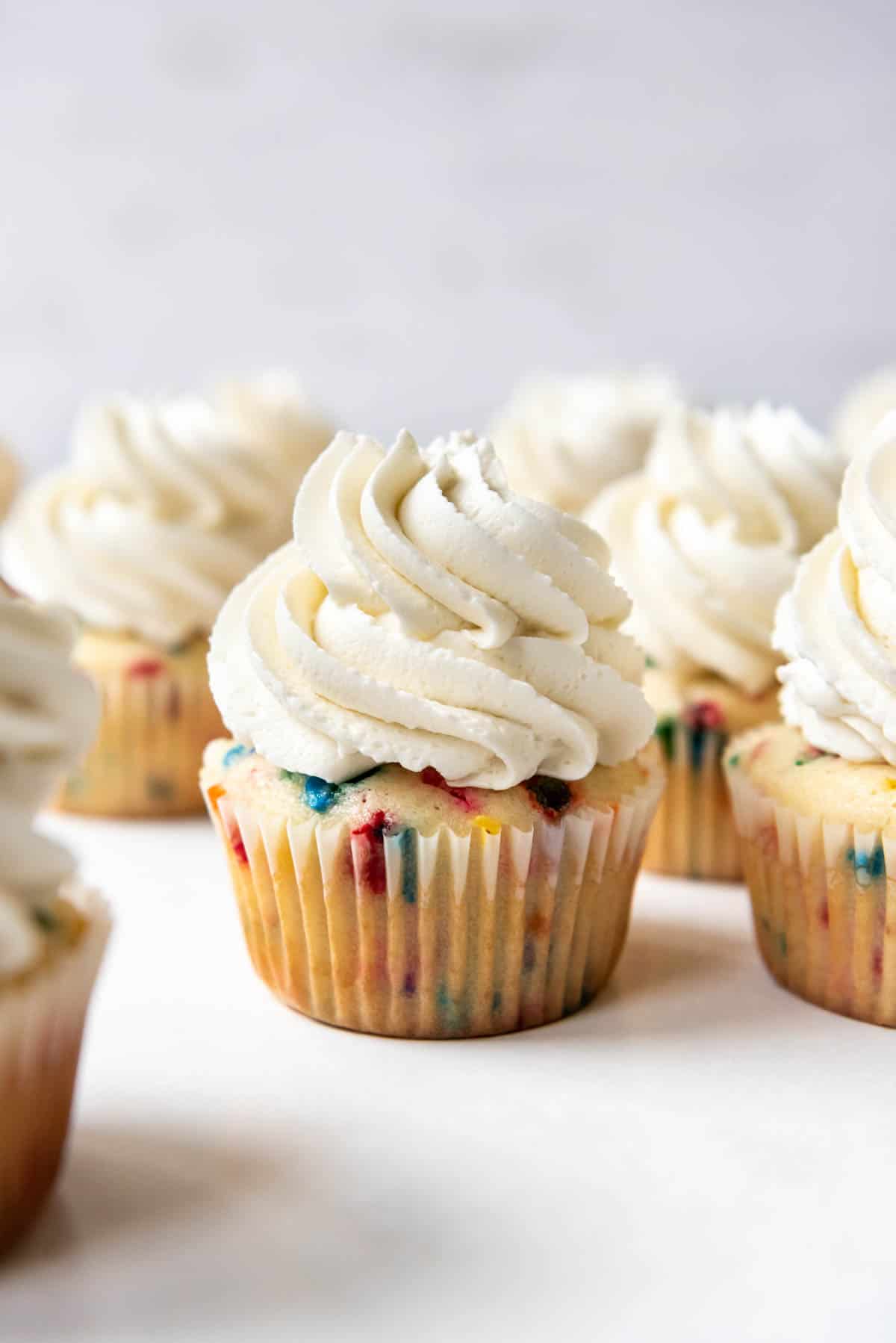
Table of Contents
- Swiss Meringue Buttercream Ingredients
- How to Make Swiss Meringue Buttercream Frosting
- Troubleshooting Swiss Meringue Frosting
- Swiss Meringue Buttercream Flavor Variations
- What is the difference between Swiss meringue buttercream and American buttercream?
- Recipe FAQ's
- Tips for Success
- How to Store Swiss Meringue Buttercream Frosting
- Favorite Cake and Cupcake Recipes for Pairing with Swiss Meringue Buttercream
- More Frosting Recipes
- Swiss Meringue Buttercream Frosting Recipe Recipe
If you have never been much of a frosting person because you find traditional American buttercream frosting tooth-achingly sweet or too heavy for your liking, then Swiss meringue buttercream just might be the answer to your cupcake woes. Many people prefer it because of it's silky, light mouthfeel and smooth, creamy, fluffy texture, as well as it's moderate sweetness.
Swiss meringue buttercream, also known as SMBC, is a luxurious frosting that is beloved by professional bakers and home cooks alike. Making Swiss meringue buttercream can seem intimidating at first since it's known for being a bit trickier than other frostings, but I'm sharing my tips for the best Swiss meringue buttercream recipe so you get beautiful smooth frosting the first time and every time!
Unlike American buttercream, Swiss meringue buttercream doesn't crust over or dry out. It's also smoother, creamier, and fluffier. You might have a strong preference for one over the other. Personally I love American buttercream, but I won't say not to a cupcake topped with a tall cloud of SMBC!
This Swiss buttercream frosting recipe is made by whipping egg whites and sugar together in a double boiler, then beating it to form a meringue, before incorporating softened butter and pure vanilla extract to create a rich and creamy frosting that holds it's shape beautifully when piped onto all kinds of baked goods and desserts.
Swiss meringue buttercream is incredibly versatile and can be flavored with a wide range of ingredients, from vanilla extract to citrus zest to peanut butter.
It's a little time-consuming, but not difficult to make. With a little practice and attention to detail, anyone can master this delicious frosting!
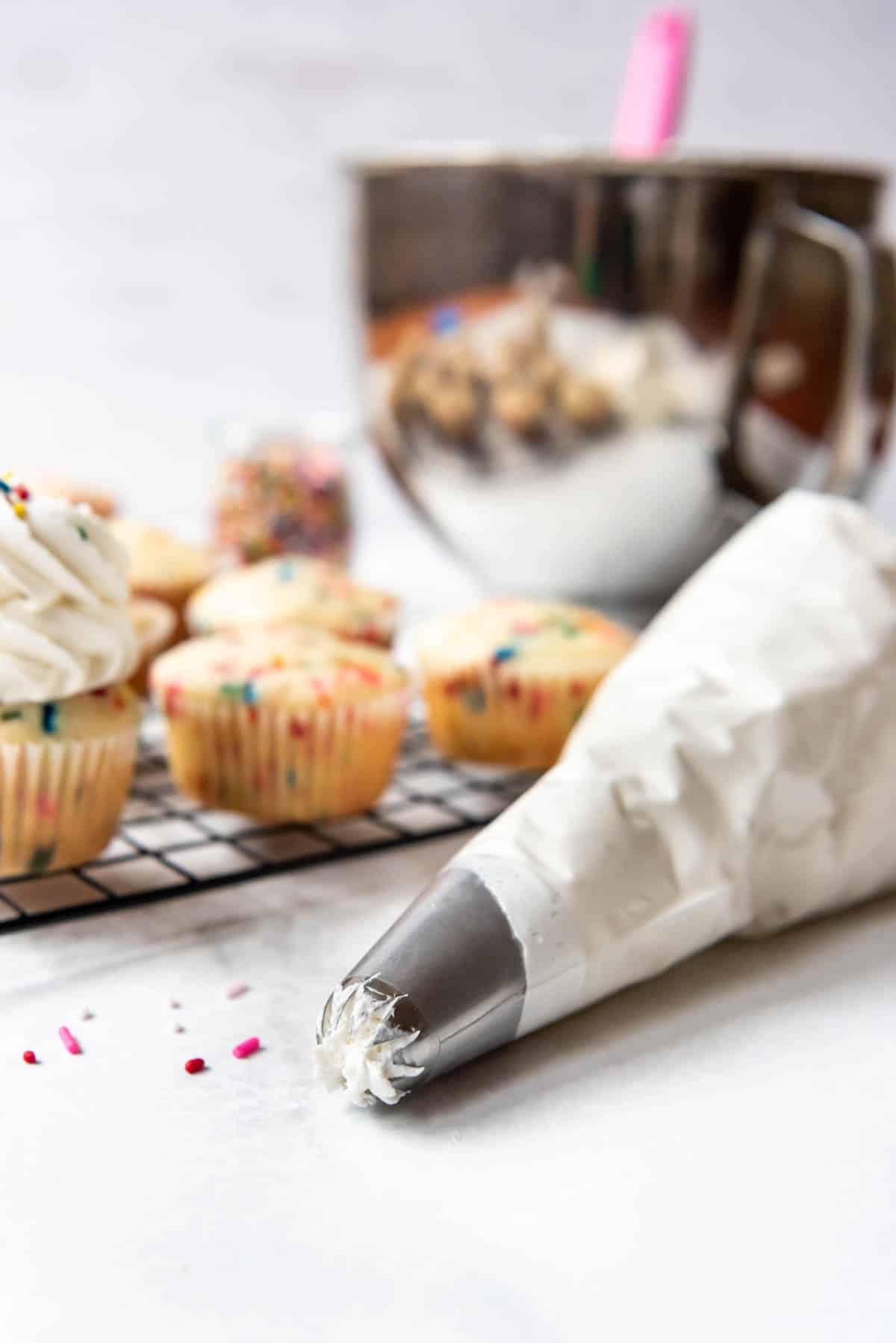
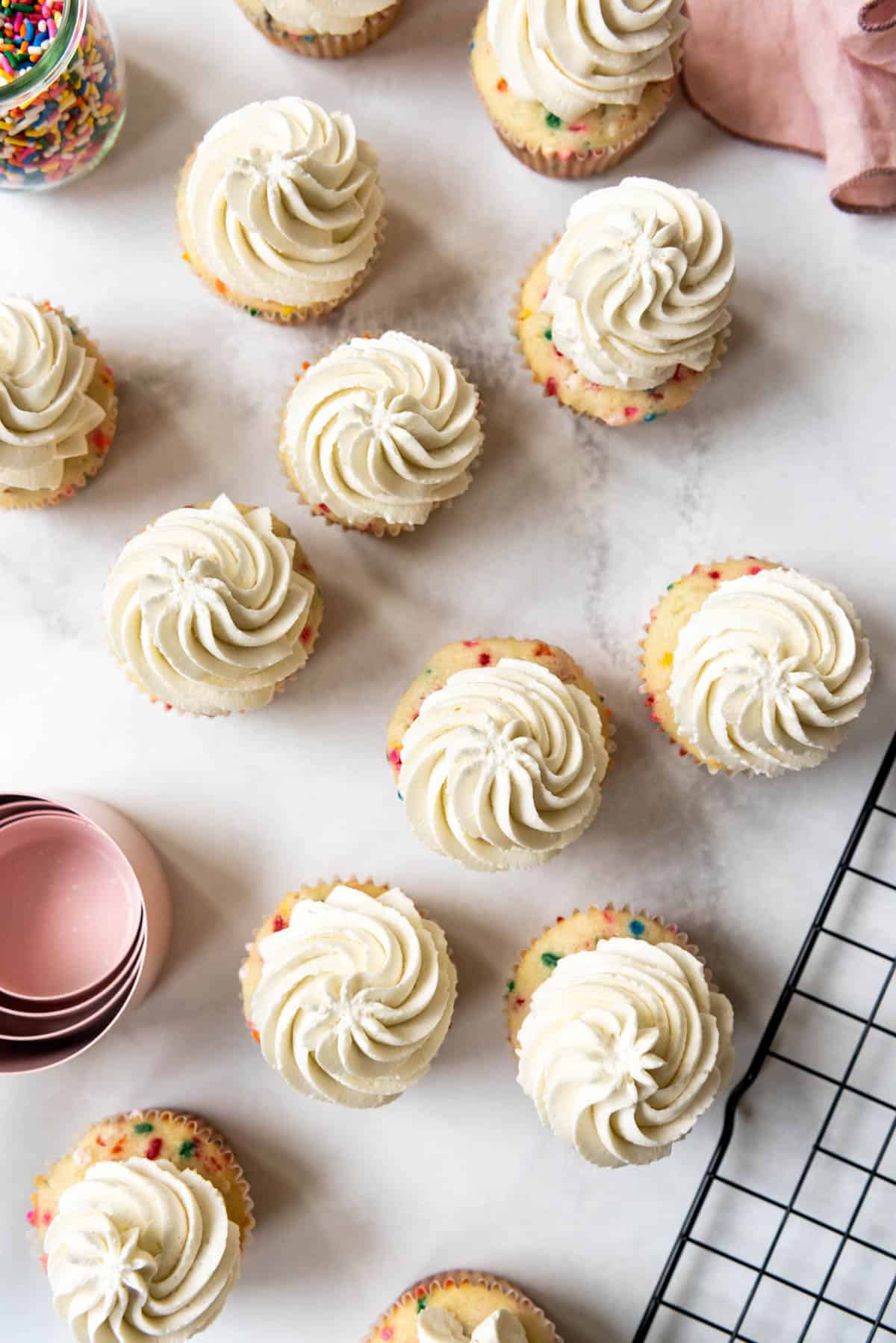
Swiss Meringue Buttercream Ingredients
Scroll down to the recipe card below this post for ingredient quantities and full instructions.
- Egg Whites - I recommend using real egg whites from fresh eggs rather than carton egg whites for best results. Use the egg yolks to make pastry cream, lemon curd, or ice cream instead.
- Granulated Sugar - Unlike American buttercream which uses powdered sugar, Swiss meringue buttercream calls for granulated sugar.
- Butter - I always use salted butter in my baking, which provides the best flavor to this Swiss buttercream frosting recipe. It should be softened just to room temperature.
- Vanilla Extract - We're making a classic vanilla Swiss meringue buttercream recipe so some pure vanilla extract will give a wonderful flavor to your frosting. See the recipe notes for some other flavor variations.
You'll also need a double boiler or a heatproof bowl set over a pot of simmering water, a candy thermometer (affiliate link), and a stand mixer or electric hand mixer.
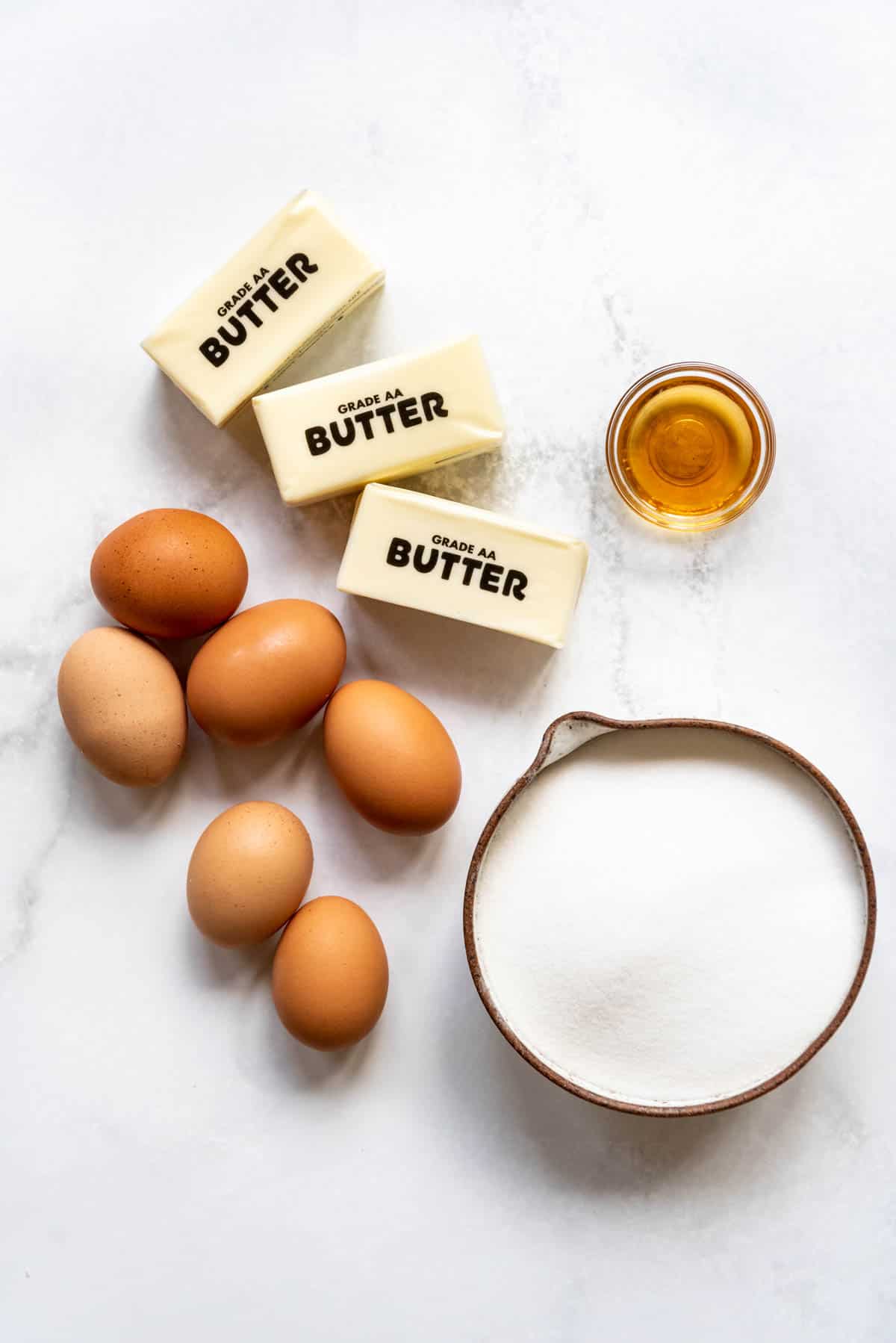
How to Make Swiss Meringue Buttercream Frosting
- Separate egg whites and egg yolks. Be careful not to get any shell or egg yolk mixed in with the egg whites, which could compromise your meringue. It's a good idea to add the egg whites one at a time into a separate bowl before adding them to the mixing bowl if you aren't confident in your separating skills.
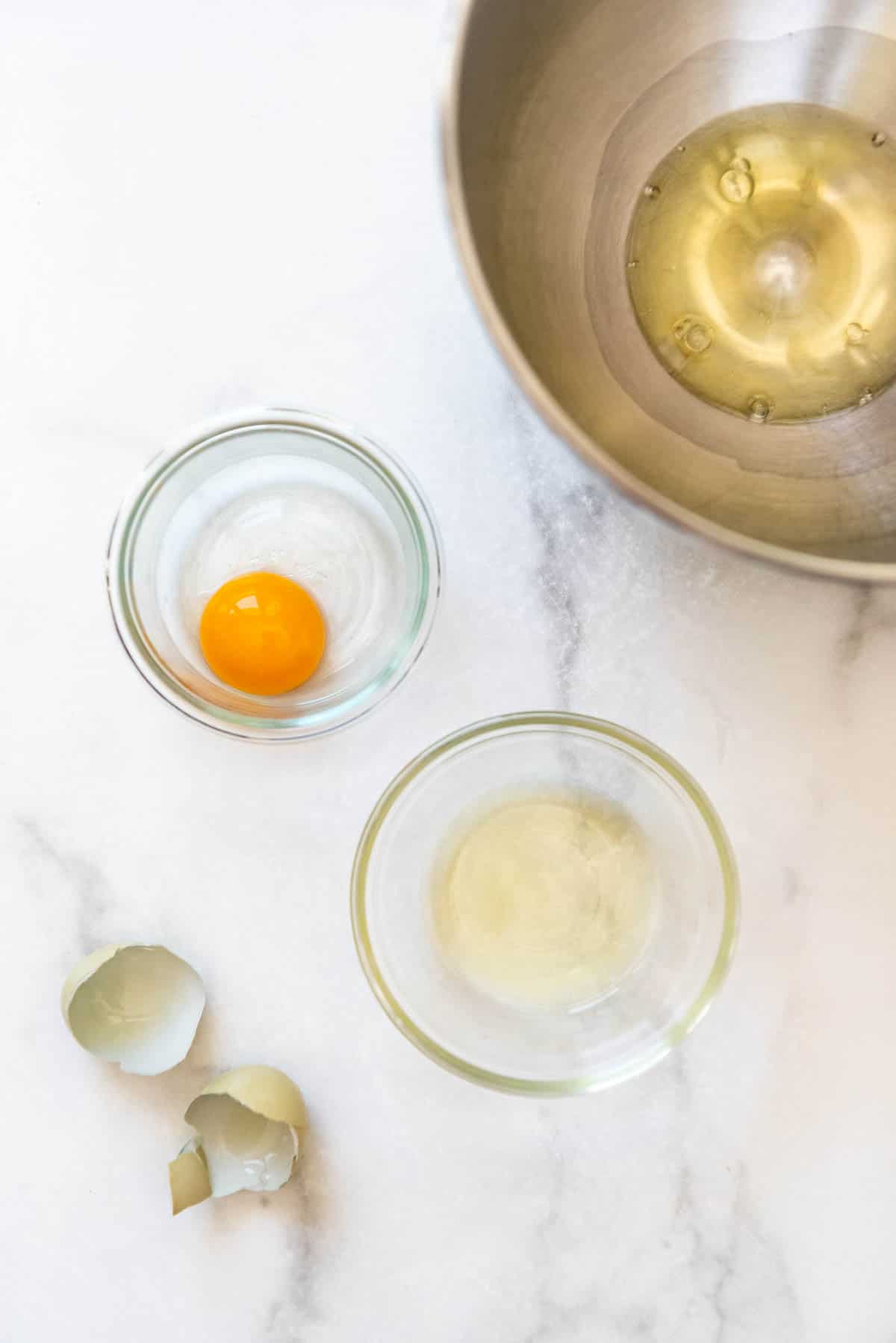
- Combine egg whites and sugar. Add the egg whites and sugar to a large heat-safe bowl that can be nested over a saucepan over simmering water like a double boiler to make a bain marie. The metal bowl that came with my KitchenAid mixer is perfect for this, although you could use a separate bowl and transfer the cooked egg whites and sugar to your mixing bowl later.
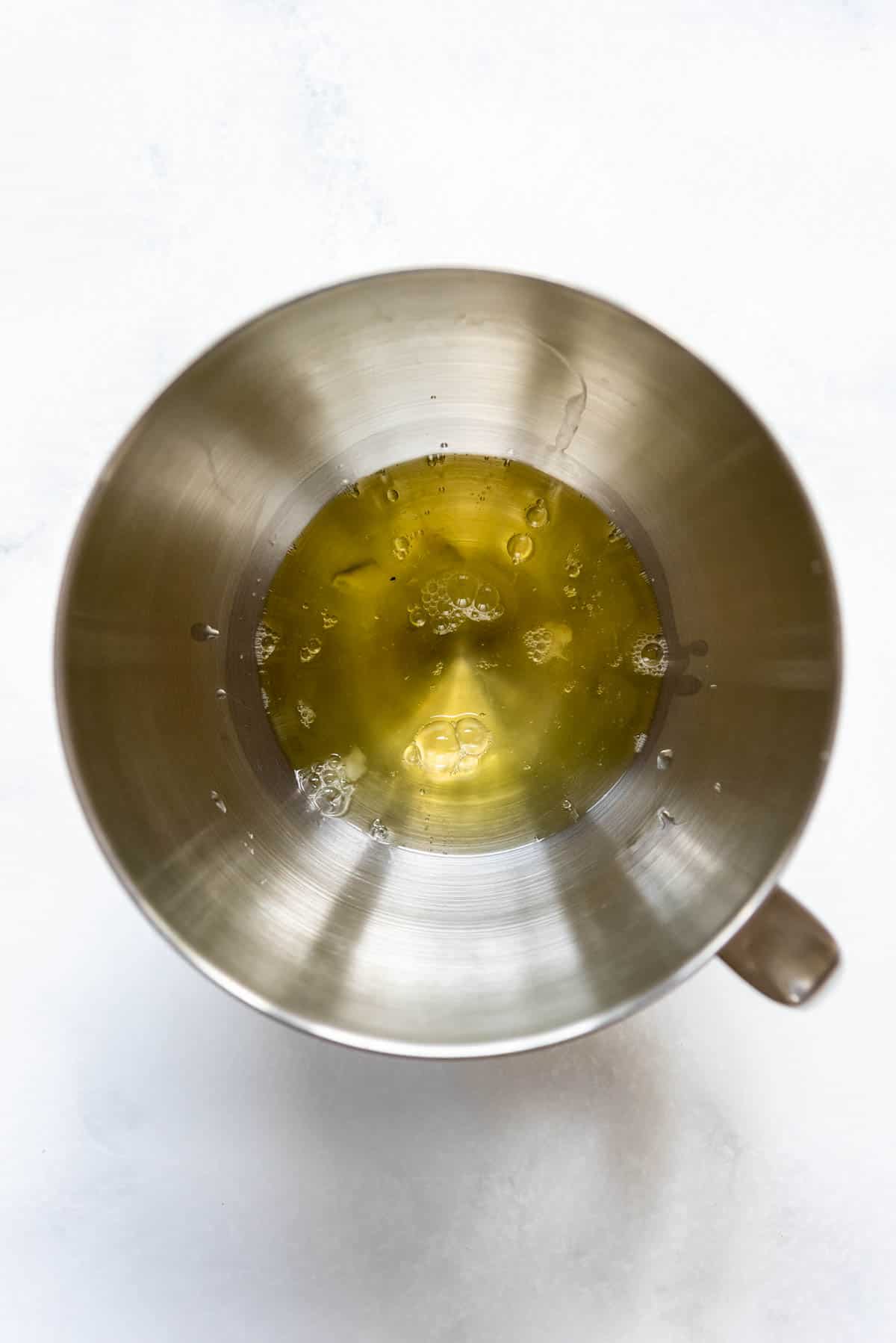

- Heat egg whites and sugar. Whisk together the egg whites and sugar in the top of your double boiler or heatproof bowl set about 2 inches over simmering water so that the bottom of the bowl is not touching the water. Whisk almost constantly until the mixture reaches 160°F (71°C) on a candy thermometer (affiliate link) or instant digital thermometer or it doesn't feel grainy when you rub some of it between your fingers. This step will ensure that the egg whites are cooked and safe to eat while simultaneously dissolving the granulated sugar and stabilizing the frosting so you end up with frosting that is smooth, not gritty.
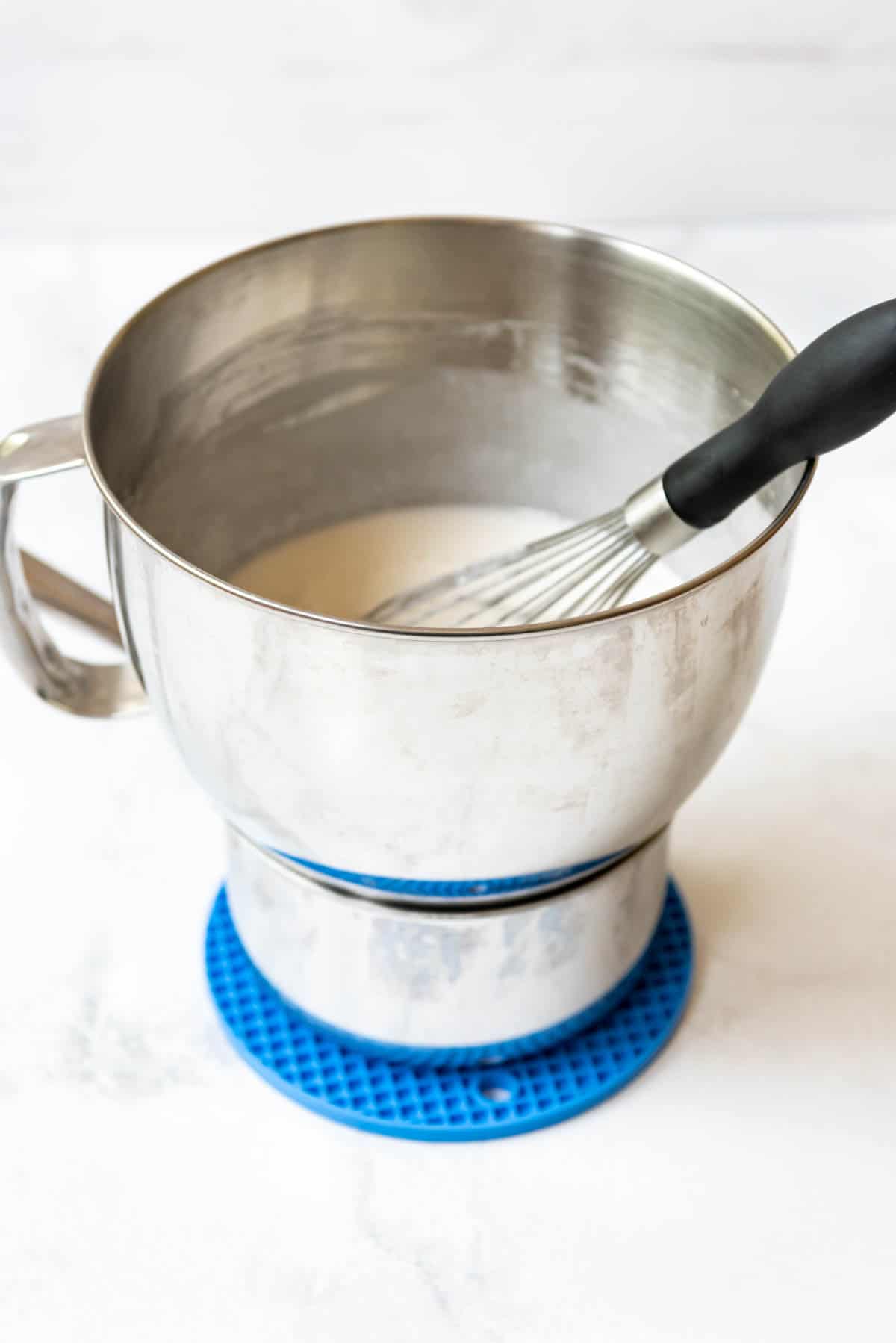
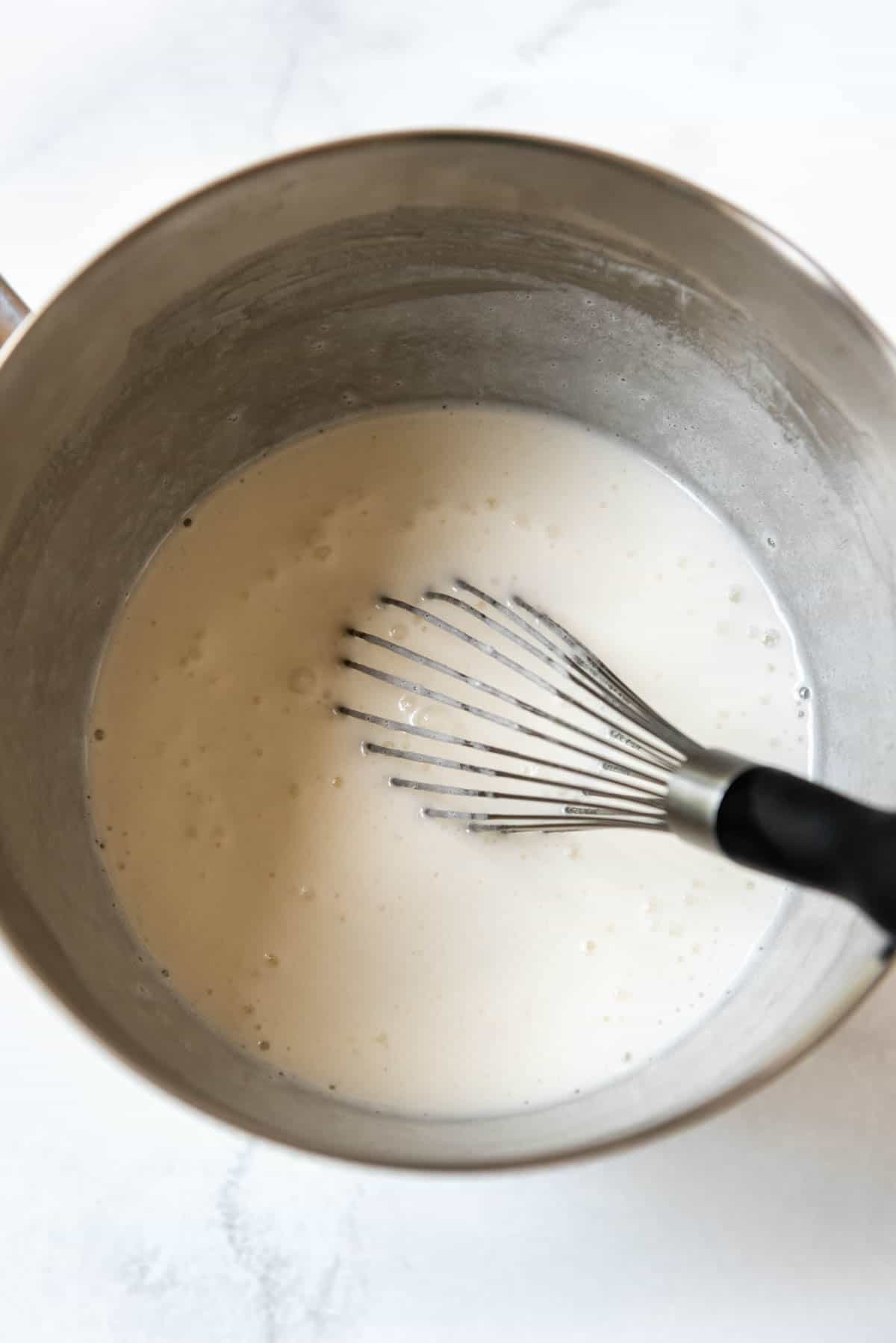

- Make the meringue. Transfer the mixture to the bowl of your stand mixer or a large mixing bowl if using a hand mixer. Using the whisk attachment, beat the egg whites and sugar on medium-high speed until stiff peaks form and the mixture has cooled to room temperature. This usually takes around 10 to 15 minutes but can take up to 20 minutes depending on how warm it is in your kitchen. Don't worry if it takes a little longer and don't rush the process. If your mixer seems to be overheating, just turn it off and let it rest for 15-20 minutes before continuing.
The meringue should be glossy and hold its shape when you lift the beater out of the bowl. The meringue and the bowl itself should also be cool to the touch so that it doesn't melt the butter when you add it in the next step. If it's still slightly warm, it won't hurt the meringue to just hang out on the counter or in the fridge for 10-15 minutes without mixing while it continues to cool, and this will prevent it from melting the butter too quickly when you add it to the frosting.
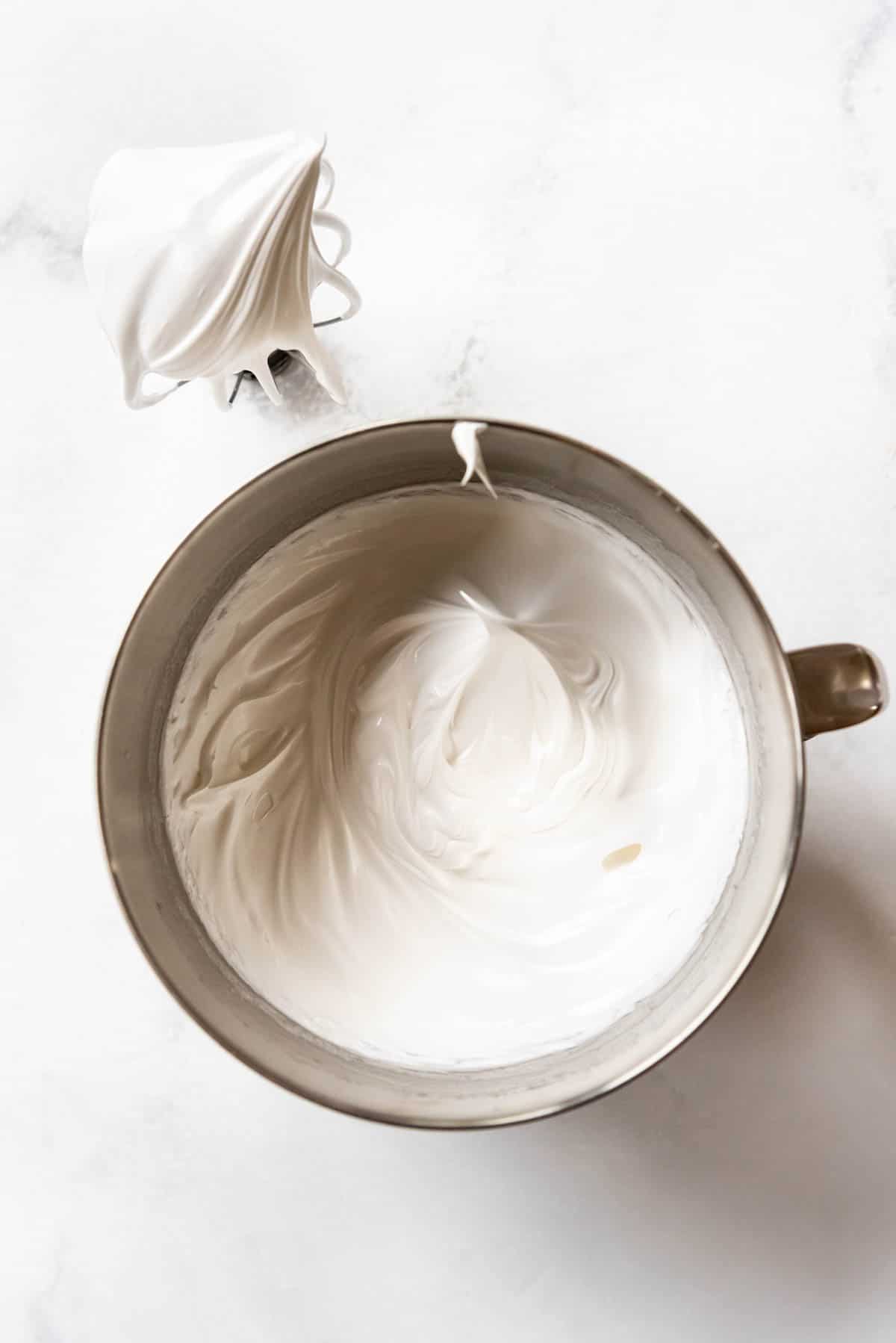
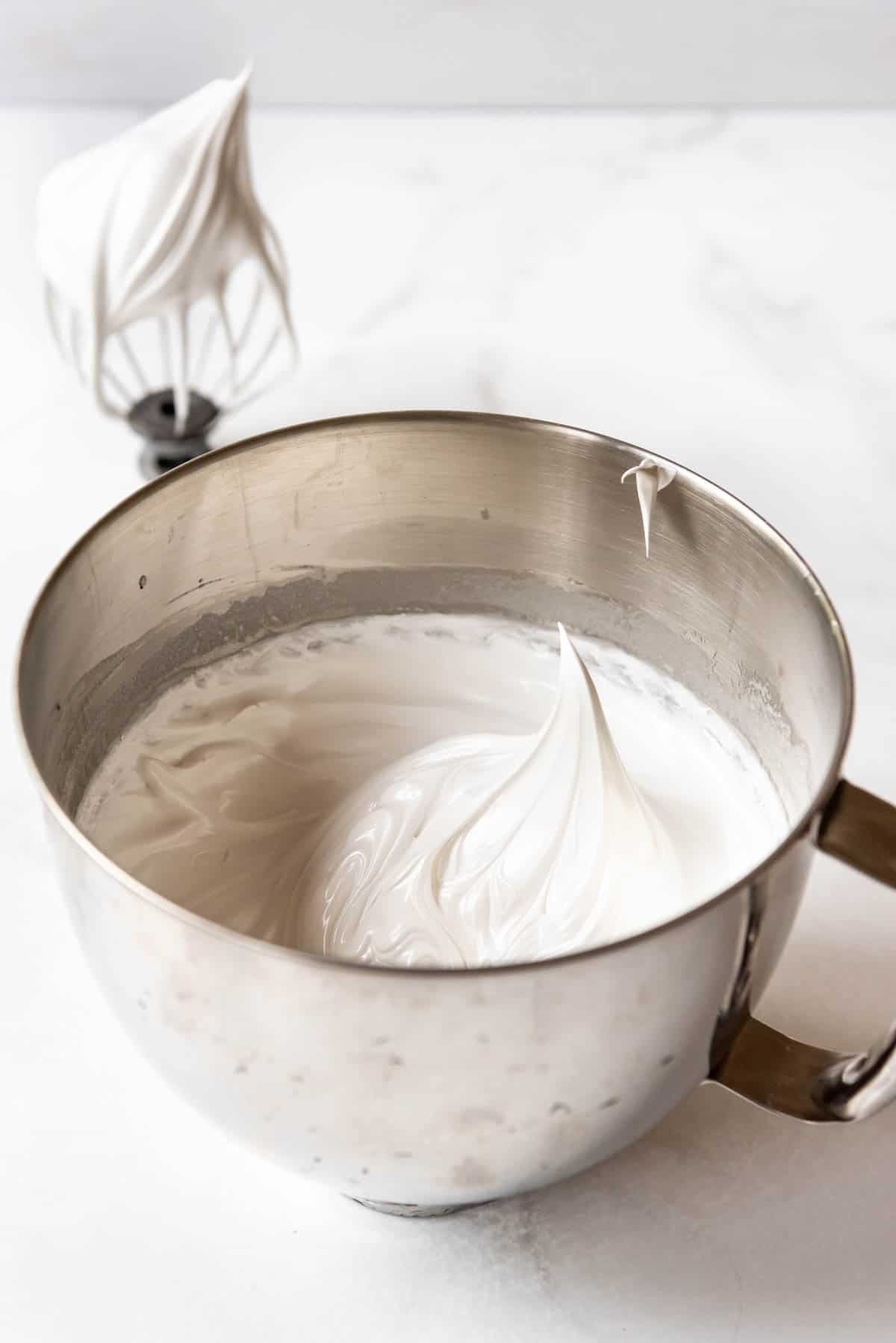
- Add butter. Once the meringue has cooled, switch to the paddle attachment and start adding the softened butter a tablespoon at a time, mixing on low speed until fully incorporated. The mixture may look curdled (in fact, it's highly likely that it will at some point) or separated or even soupy at first (especially if your meringue was still warm), but keep mixing and it will eventually come together into a smooth and creamy frosting. If not, see my troubleshooting tips below. The good news is that there is almost always a way to fix SMBC if it is giving you issues!
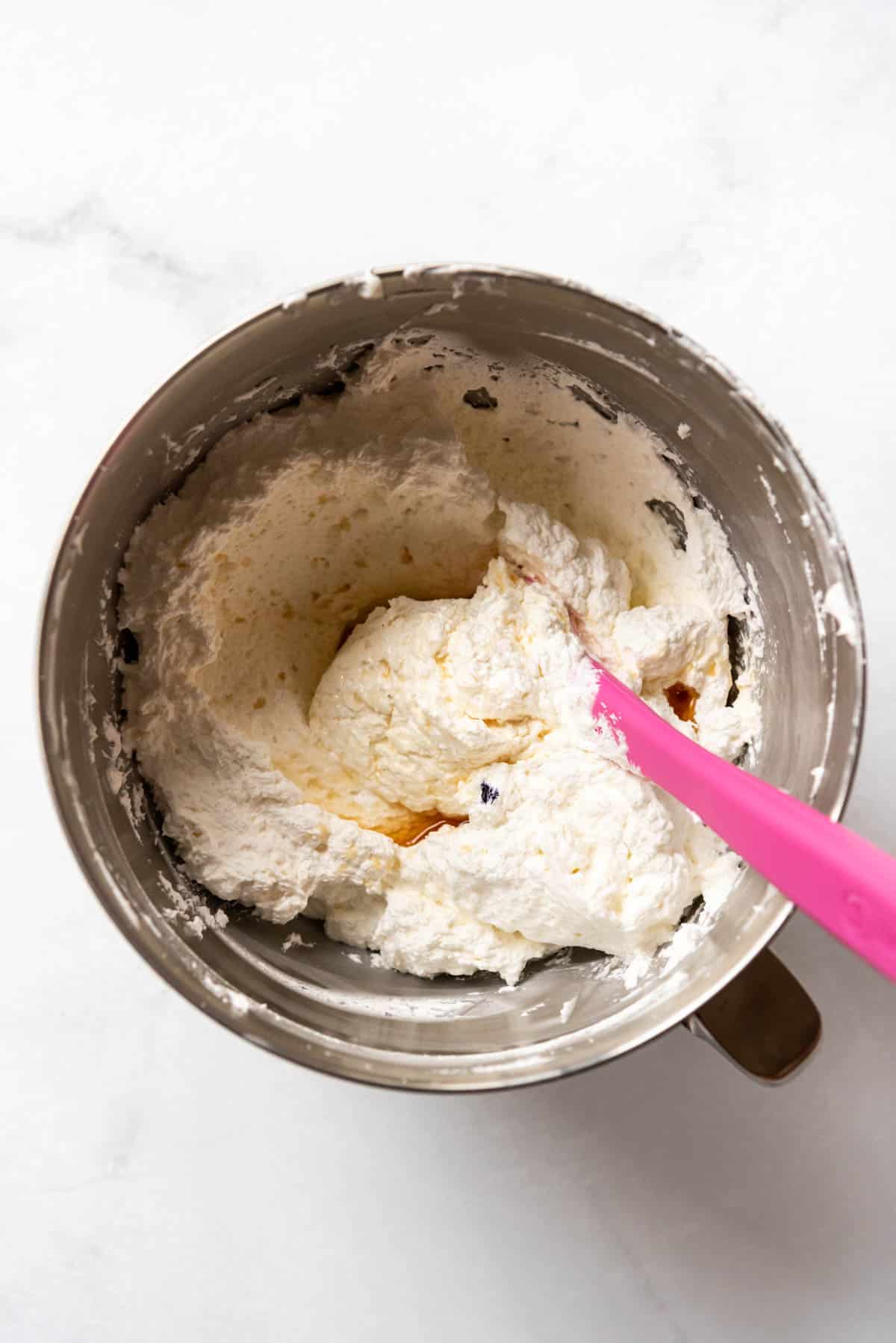

- Add flavor and color (if desired). Once all of the butter has been added, you can add the vanilla extract (or whatever flavoring you choose - see notes) and gel food coloring (affiliate link). Because all of the butter tends to tint Swiss buttercream a pale yellow, you might want to correct the color with a tiny amount (like half a drop) of violet food coloring (affiliate link) to counteract the yellow.
- Remove air bubbles. This frosting takes a lot of mixing and that can create air bubbles. For a super smooth frosting, decrease the speed to low and continue to mix for 5 to 8 minutes to smooth out the frosting and remove some of the air bubbles. You can also do this by hand by stirring with a spatula and pressing the frosting against the sides of the bowl to smooth it out for a creamier frosting.
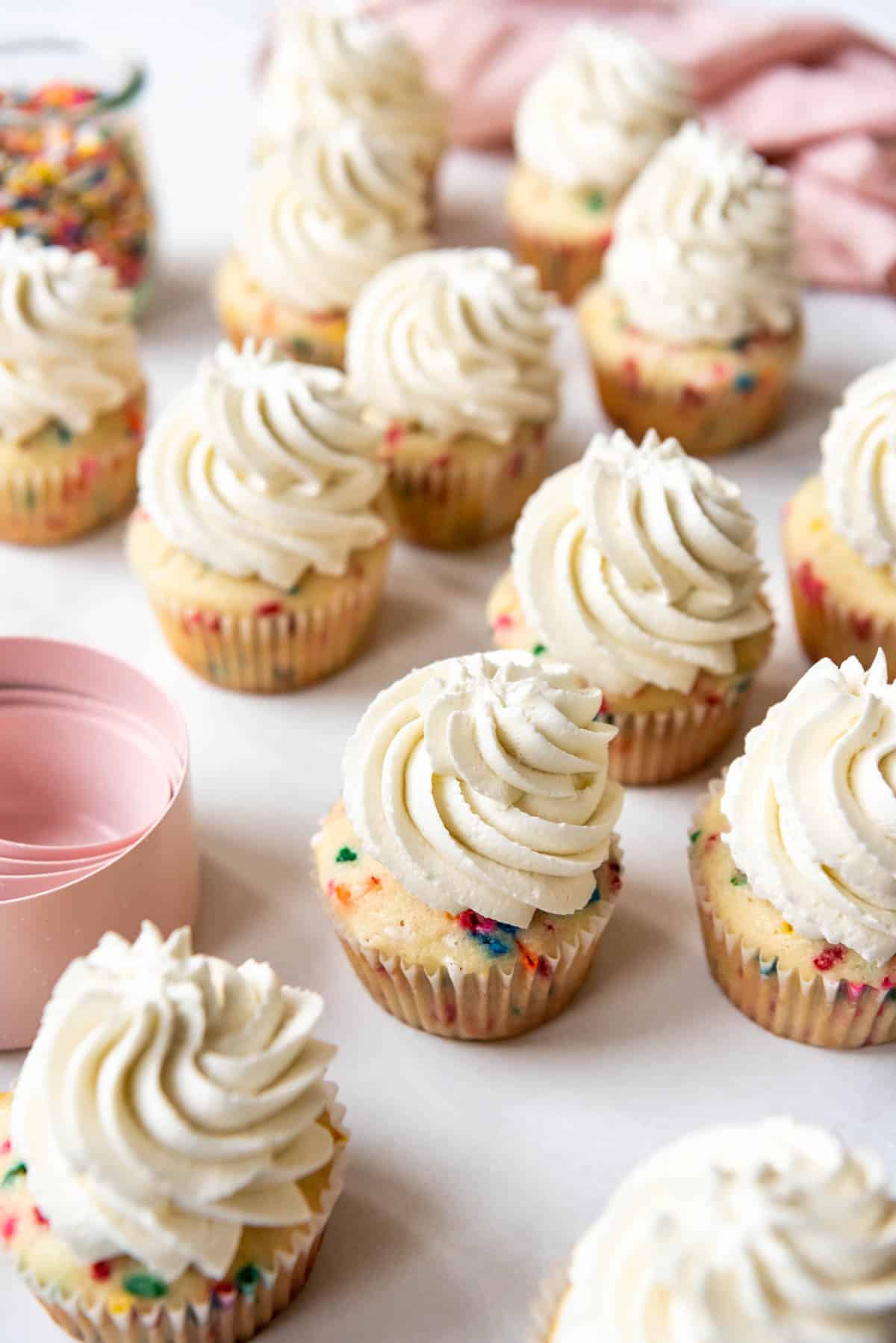
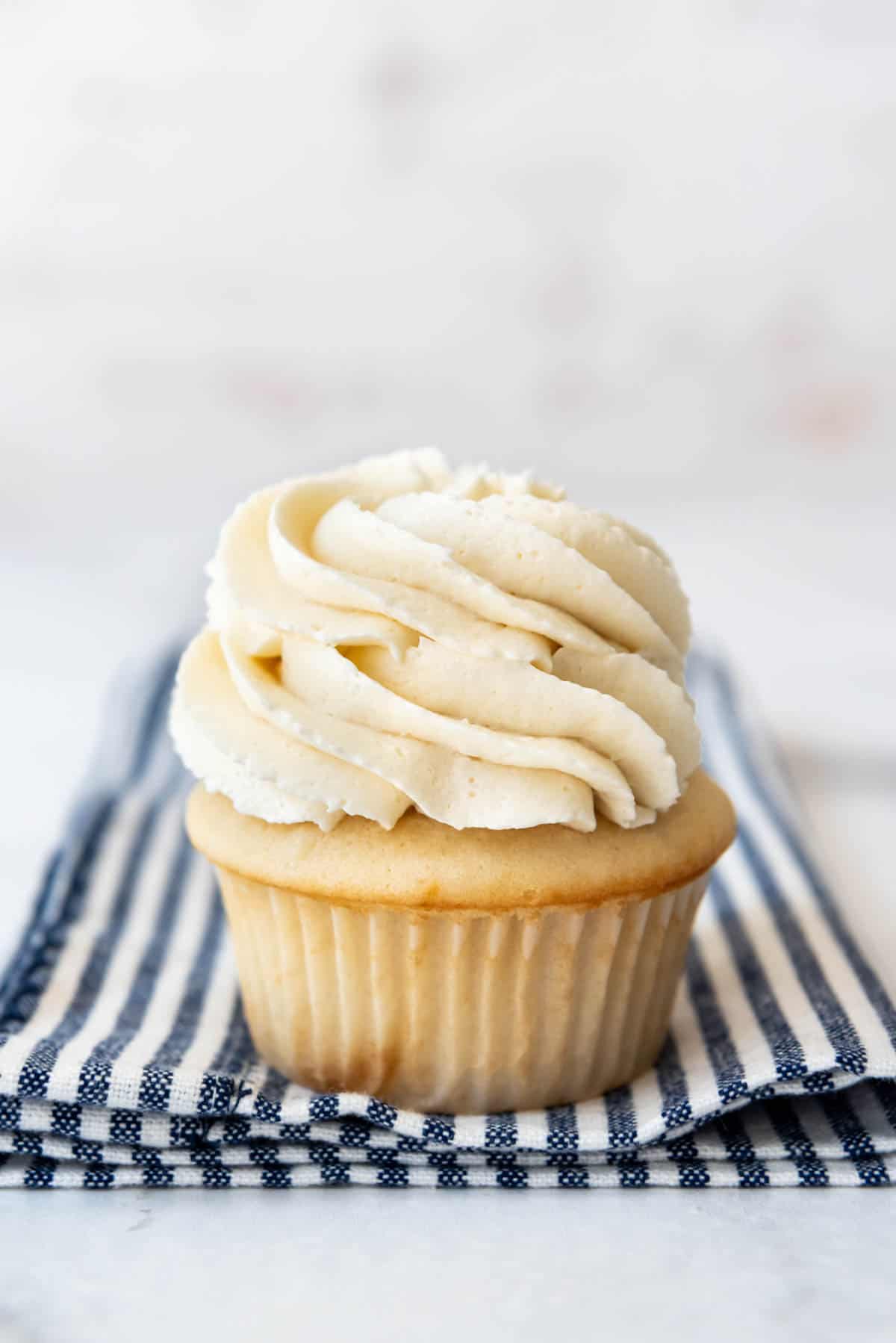
Troubleshooting Swiss Meringue Frosting
The long and short of things is that Swiss meringue buttercream can be tricky to make. It just the nature of the frosting. If you've ended up with a "ruined" batch of SMBC, don't panic - there are several ways to fix it and salvage your frosting.
Here are some common problems that can occur when making Swiss meringue buttercream and how to fix them:
- The buttercream is too runny or soupy: This can happen if the butter was too soft or if the meringue was not whipped to stiff peaks or was still too warm when adding the butter. To fix this, place the buttercream in the refrigerator for 15-20 minutes to firm up the butter, then whip it again with a stand mixer or hand mixer until it thickens to the desired consistency. If it is still soupy, stick it back in the fridge for longer to cool down.
- The buttercream is curdled or separated: This can happen if the butter was too cold or if it was added too quickly to the meringue. To fix this, keep beating for 5 minutes! Or if it is still a problem, you can remove a small portion of the curdled buttercream (about 1 cup) and microwave it for a few seconds (like 10 to start) until it is melted but not hot. With the mixer running on low speed, slowly pour the melted buttercream back into the mixing bowl and continue to mix until the frosting is smooth and creamy. Another option is to stick the bowl back over simmering water and let it sit for 1-2 minutes. This will melt the butter around the outside edges of the bowl without melting the frosting in the middle. Once you mix everything together it should smooth things out.
- The buttercream is too sweet: To fix this, try adding an extra pinch of salt to balance out the sweetness. You can also try adding up to ½ cup additional butter without changing any of the other ingredients to dilute the sweetness and increase the butter ratio. Personally I have never had this be an issue for me with SMBC, but I also like really sweet frostings like American buttercream.
Swiss Meringue Buttercream Flavor Variations
Swiss meringue buttercream (SMBC) is a versatile frosting that can be flavored in many different ways. Here are some popular flavor variations for SMBC:
- Vanilla: The classic flavor for SMBC is vanilla, which is made by adding vanilla extract or vanilla bean paste to the buttercream, which gives lovely flecks of vanilla bean.
- Chocolate: To make chocolate Swiss meringue buttercream, add 6 ounces of melted, cooled semi-sweet or bittersweet chocolate to the buttercream after mixing in all of the butter and vanilla extract. Mix on low speed until fully incorporated, stopping to scrape down the sides of the bowl as needed. Once the chocolate is combined with the other frosting ingredients, increase the speed to medium and mix until the chocolate Swiss meringue buttercream is smooth and creamy. You can also add up to 2 Tablespoons of cocoa powder along with the melted chocolate for an even more intense chocolate flavor.
- Fruit: You can add up to about ¼ cup of fruit puree, such as raspberry, strawberry, or mango, to SMBC to create a fruity frosting. Be sure to strain the puree to remove any seeds or pulp before adding it to the buttercream. Another option is to use freeze-dried fruit that has been ground into a fine powder.
- Caramel: To make caramel SMBC, add ½ cup of homemade caramel sauce or store-bought caramel sauce to the buttercream.
- Citrus: 1-2 Tablespoons of lemon zest, lime zest, or orange zest can be added to SMBC for a tangy and refreshing flavor.
- Almond: Add ½ to 1 teaspoon almond extract to SMBC for a nutty flavor.
- Other extracts: Mint, orange, raspberry, coconut, cherry, rum, or other extracts can be added for more flavor variations. For these stronger extracts, I would recommend starting with ½ teaspoon and going from there.
- Spices: Cinnamon, nutmeg, ginger, apple pie spice, or pumpkin pie spice can be added to SMBC to create a warm and cozy flavor.
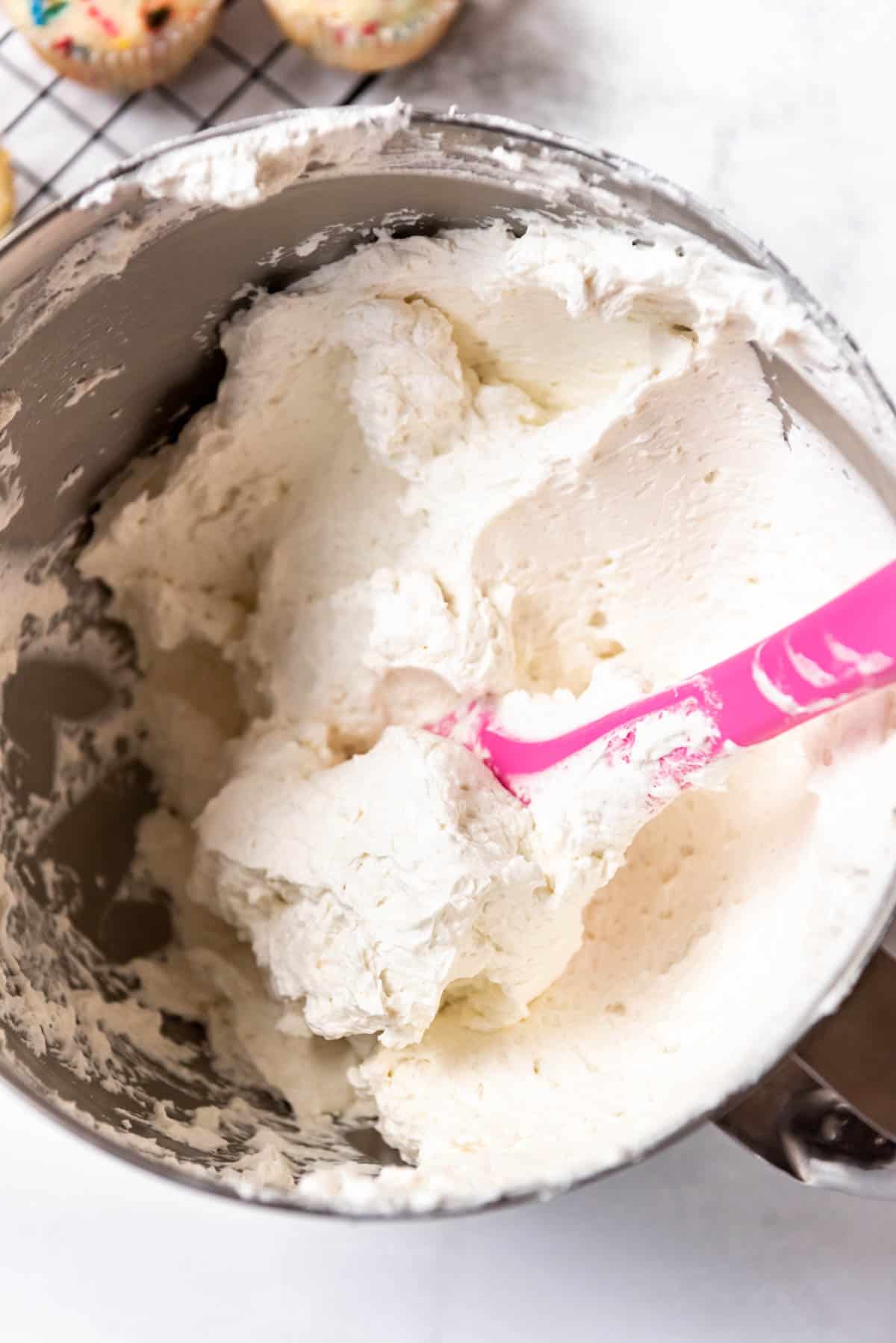
What is the difference between Swiss meringue buttercream and American buttercream?
Swiss meringue buttercream and American buttercream frosting are two types of buttercream frostings that differ in their ingredients, preparation, texture, and taste. American buttercream is quicker and easier to prepare and has a sweeter taste. SMBC takes longer but it is fluffier and less sweet.
Here are some of the key differences between the two:
Ingredients: SMBC is made from whipped egg whites, sugar, and butter, while American buttercream is made from powdered sugar, butter, and milk or cream. SMBC has a lighter texture and a less sweet taste compared to American buttercream.
Preparation: To make SMBC, the egg whites and sugar are cooked together over a double boiler until the sugar dissolves, and then whipped until stiff peaks form. Butter is then added slowly to the whipped egg whites until the mixture becomes smooth and creamy. For American buttercream, powdered sugar and butter are whipped together until light and fluffy, and then milk or cream is added to achieve the desired consistency.
Texture: SMBC has a silky, light, and fluffy texture that makes it easy to spread and pipe. American buttercream is dense, heavy, and grainy due to the high amount of powdered sugar used.
Taste: SMBC has a delicate, buttery flavor that complements a wide range of desserts. Its sweetness is more subtle than that of American buttercream, which has a very sweet taste due to the high amount of powdered sugar used.
Recipe FAQ's
Technically, yes, although then it would be French meringue buttercream, rather than Swiss. But if you have pasteurized eggs, then by all means go for it! The only change I would make it to start whisking the egg whites alone and gradually add the granulated sugar little by little, a tablespoon at a time, to help it dissolve better without the heat.
I'm aware that many bakers use unsalted butter in their SMBC recipes but I never use it. The difference between unsalted and salted butter and just ¼ teaspoon of salt per stick. It's not enough to make a huge difference in most baking recipes so I never bother to buy it any more, largely because I'm lazy and don't want to worry about keeping multiple types of butter in my fridge, but also because I have been burned too many times to count by accidentally spreading unsalted butter on my morning toast.
I have made SMBC both ways with both types of butter (if using unsalted butter you will want to add a little extra salt anyway) and I have never had any complaints about my SMBC made with salted butter being too salty.
Temperature: If the butter is too cold, it won't incorporate well with the meringue, resulting in curdling. On the other hand, if the butter is too warm, it can cause the buttercream to become too runny. Make sure the butter is at room temperature, around 68-72°F (20-22°C), before adding it to the meringue.
Over-whipping: Over-whipping the meringue can cause it to become dry and grainy, which can then lead to curdling when the butter is added. Make sure not to use high speed and to stop whipping the meringue when it reaches stiff peaks and is still glossy.
Humidity: High humidity can cause the butter to soften too quickly, leading to curdling.
Tips for Success
- The butter shouldn't be too soft. Don't pull it out more than 30-45 minutes before you plan to add it to your Swiss meringue buttercream. It should be on the cool side of room temperature - around 60°F if you want to test it with an instant digital thermometer.
- If you only have unsalted butter, just add ¼ teaspoon of salt to the buttercream when adding the butter.
- I like to separate the egg yolks and egg whites while the eggs are still cold from the fridge. There is no need to worry about letting them come to room temperature because they will be cooked anyway.
- Make sure your bowl is free from any grease and that there are no egg yolks mixed in with the egg whites when making the meringue. Either situation can prevent the meringue from whipping up properly. Wiping down the bowl with a cut lemon or a little vinegar then rinsing and drying it well can be a good idea if you have had trouble getting the volume into your meringue in the past.
- I don't recommend using carton egg whites. Some people do and claim it works fine, but I have never had luck with making meringue from carton egg whites.
How to Store Swiss Meringue Buttercream Frosting
Swiss meringue buttercream can be left out at room temperature for up to 2 days, so it's great for making ahead. It can also be refrigerated for 1-2 weeks and it freezes beautifully for up to 3 months, so you can even make extra batches to have on hand for occasions when you know you are likely to be pressed for time.
Just be sure if refrigerating or freezing buttercream frosting that you let it sit out at room temperature for 3-4 hours to thaw completely, then beat it again with your mixer so it is fluffy, spreadable, and smooth before using.
To store Swiss meringue buttercream, transfer it to an airtight container. If refrigerating or freezing, let it come to room temperature and then whip it again until it's smooth and creamy.
Favorite Cake and Cupcake Recipes for Pairing with Swiss Meringue Buttercream
- Best Chocolate Cupcakes
- Moist Vanilla Cupcakes
- Fresh Strawberry Cupcakes
- Devil's Food Cake
- Lemon Cupcakes
- San Jose Burnt Almond Cake
- Homemade Funfetti Cake
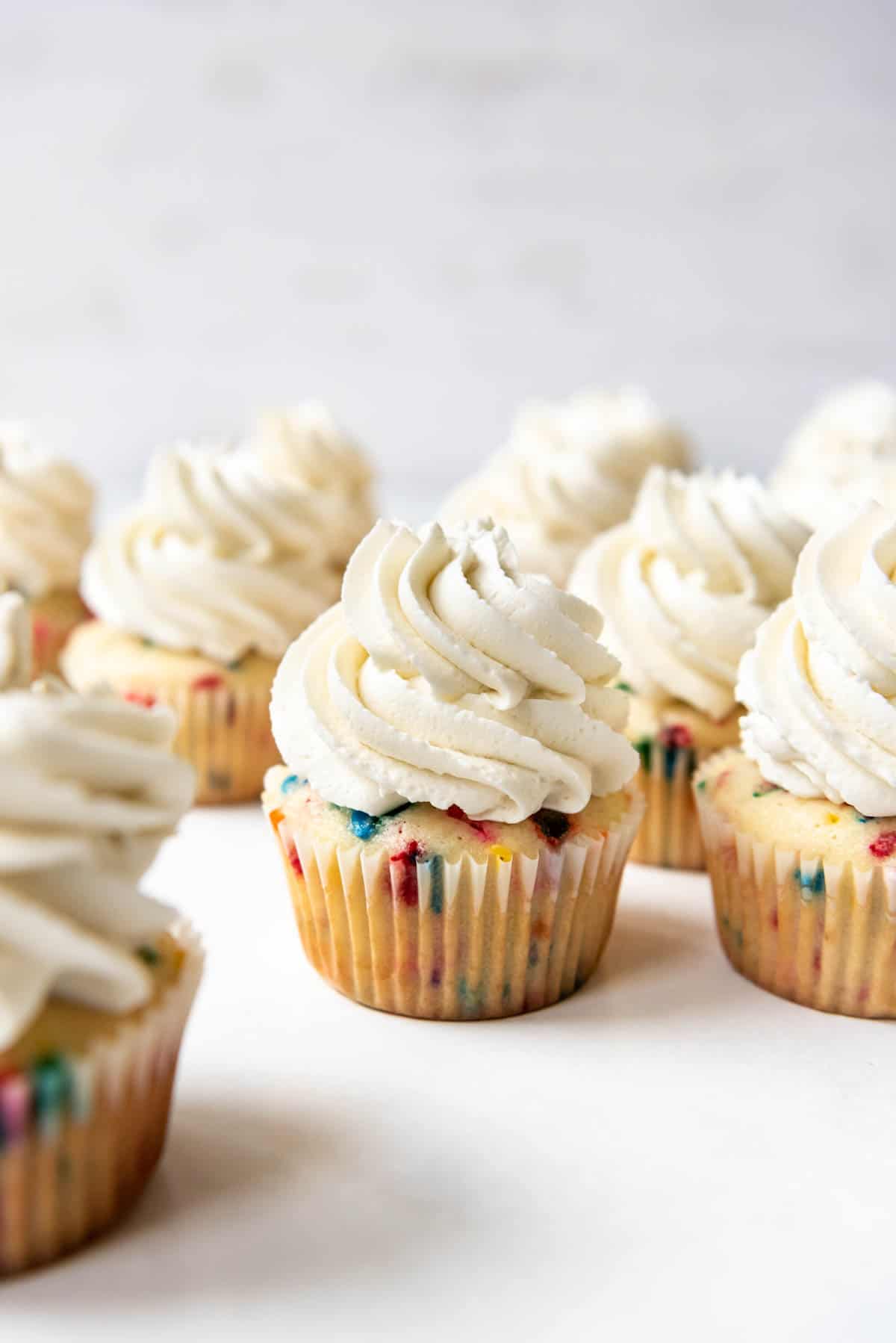
More Frosting Recipes
- Best Cream Cheese Frosting
- German Chocolate Cake Frosting
- Lemon Buttercream Frosting
- Cookies & Cream Oreo Frosting
- Easy Salted Caramel Frosting
Frostings
Homemade Chocolate Frosting
Cuisine
Vanilla Buttercream Frosting
Frostings
Fresh Strawberry Frosting
Did you make this recipe?
Let me know what you thought with a comment and rating below. You can also take a picture and tag me on Instagram @houseofnasheats or share it on the Pinterest pin so I can see.
Swiss Meringue Buttercream Frosting Recipe
Ingredients
- 6 large egg whites (about 230g)
- 2 cups granulated sugar (400g)
- 1 ½ cups salted butter, cut into Tablespoon-sized cubes, softened but still cool
- 2 teaspoons vanilla extract
Instructions
- Separate egg yolks and egg whites. Save yolks for making ice cream, pastry cream, lemon curd, or another use.
- Transfer egg whites to a heat proof bowl. Whisk in sugar. Nestle bowl into a saucepan with simmering water so the bottom of the bowl isn't touching the water. Whisk for about 4 minutes until the sugar has dissolved and reaches 160°F on an instant digital thermometer.
- Transfer to a stand mixer with a whisk attachment. Beat on medium-high until stiff peaks form. They should be glossy and have cooled. This will take 10-15 minutes, even up to 20 minutes depending on the temperature of your kitchen. The meringue should no longer be warm to the touch.
- Switch to paddle attachment. Add the butter 1 Tablespoon at a time while mixing on medium-high speed. Watch for butter to be mixed in completely before adding more butter. Reduce speed to medium and add vanilla extract. If you want to have perfectly white frosting, add a tiny amount (like half a drop) of violet gel food coloring (affiliate link) to counteract the yellow from the butter. Works like a charm.
Notes
- Yield: Makes about 5 cups or enough frosting for a two-layer 8" or 9" inch cake, about 12 cupcakes with a tall cloud of frosting piped onto it, or about 24 cupcakes if you are just spreading a smaller amount of frosting on them with a knife.
- Make Ahead: Swiss meringue buttercream can be left out at room temperature for up to 2 days, so it's great for making ahead. To store Swiss meringue buttercream, transfer it to an airtight container. If refrigerating or freezing, let it come to room temperature and then whip it again until it's smooth and creamy.
- Storing: SMBC can be refrigerated for 1-2 weeks and it freezes beautifully for up to 3 months, so you can even make extra batches to have on hand for occasions when you know you are likely to be pressed for time. Just be sure if refrigerating or freezing buttercream frosting that you let it sit out at room temperature for 3-4 hours to thaw completely, then beat it again with your mixer so it is fluffy, spreadable, and smooth before using.
- Troubleshooting runny SMBC: This can happen if the butter was too soft or if the meringue was not whipped to stiff peaks or was still too warm when adding the butter. To fix this, place the buttercream in the refrigerator for 15-20 minutes to firm up the butter, then whip it again with a stand mixer or hand mixer until it thickens to the desired consistency. If it is still soupy, stick it back in the fridge for longer to cool down.
- Troubleshooting curdled or separated SMBC: This can happen if the butter was too cold or if it was added too quickly to the meringue. To fix this, keep beating for 5 minutes! Or if it is still a problem, you can remove a small portion of the curdled buttercream (about 1 cup) and microwave it for a few seconds (like 10 to start) until it is melted but not hot. With the mixer running on low speed, slowly pour the melted buttercream back into the mixing bowl and continue to mix until the frosting is smooth and creamy. Another option is to stick the bowl back over simmering water and let it sit for 1-2 minutes. This will melt the butter around the outside edges of the bowl without melting the frosting in the middle. Once you mix everything together it should smooth things out
- Trouble shooting SMBC that is too sweet: To fix this, try adding an extra pinch of salt to balance out the sweetness. You can also try adding up to ½ cup additional butter without changing any of the other ingredients to dilute the sweetness and increase the butter ratio. Personally I have never had this be an issue for me with SMBC, but I also like really sweet frostings like American buttercream
- Fruit Variation: You can add up to about ¼ cup of fruit puree, such as raspberry, strawberry, or mango, to SMBC to create a fruity frosting. Be sure to strain the puree to remove any seeds or pulp before adding it to the buttercream. Another option is to use freeze-dried fruit that has been ground into a fine powder.
- Chocolate Variation: To make chocolate Swiss meringue buttercream, add 6 ounces of melted, cooled semi-sweet or bittersweet chocolate to the buttercream after mixing in all of the butter and vanilla extract. Mix on low speed until fully incorporated, stopping to scrape down the sides of the bowl as needed. Once the chocolate is combined with the other frosting ingredients, increase the speed to medium and mix until the chocolate Swiss meringue buttercream is smooth and creamy. You can also add up to 2 Tablespoons of cocoa powder along with the melted chocolate for an even more intense chocolate flavor.
- Caramel Variation: To make caramel SMBC, add ½ cup of homemade caramel sauce or store-bought caramel sauce to the buttercream.
- Citrus Variation: 1-2 Tablespoons of lemon zest, lime zest, or orange zest can be added to SMBC for a tangy and refreshing flavor.
- Almond Variation: Add ½ to 1 teaspoon almond extract to SMBC for a nutty flavor.
- Other extracts: Mint, orange, raspberry, coconut, cherry, rum, or other extracts can be added for more flavor variations. For these stronger extracts, I would recommend starting with ½ teaspoon and going from there.
- Spices: Cinnamon, nutmeg, ginger, apple pie spice, or pumpkin pie spice can be added to SMBC to create a warm and cozy flavor.
- Nutrition: The nutrition information was calculated using an online tool based upon dividing the frosting into 12 servings (enough for 1 cupcake with a big swirl of frosting on it or one slice of cake). However, I am not a nutritionist and for the most accurate results, you may want to do your own calculations.
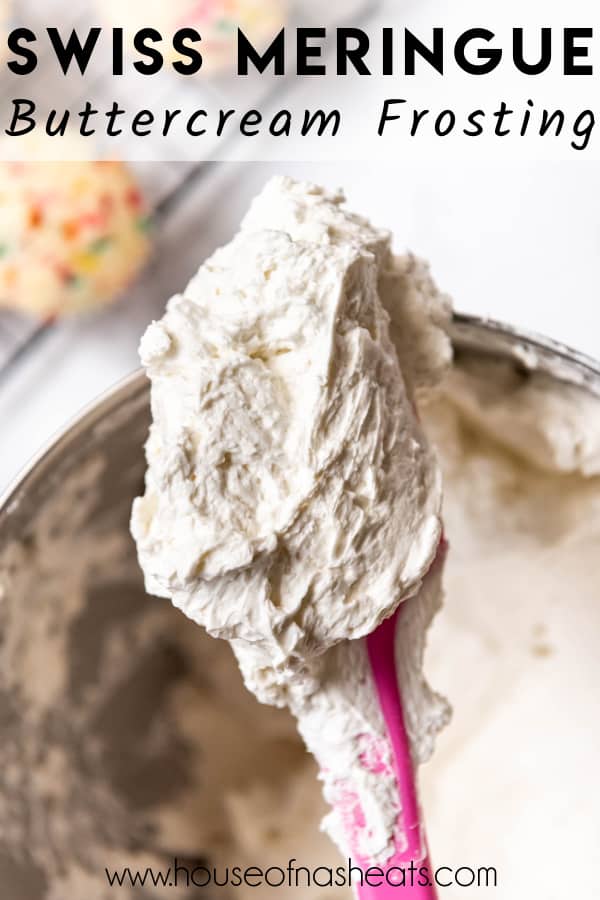
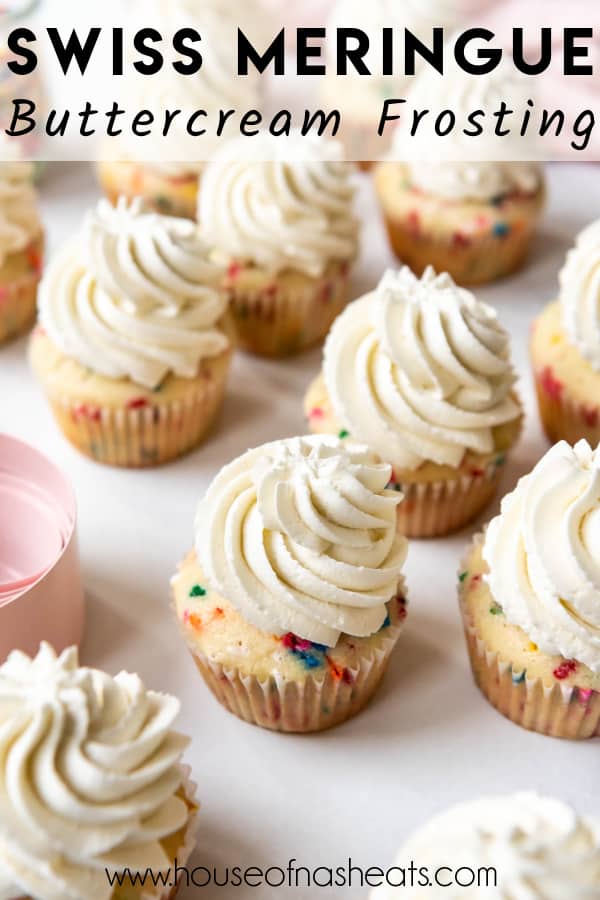
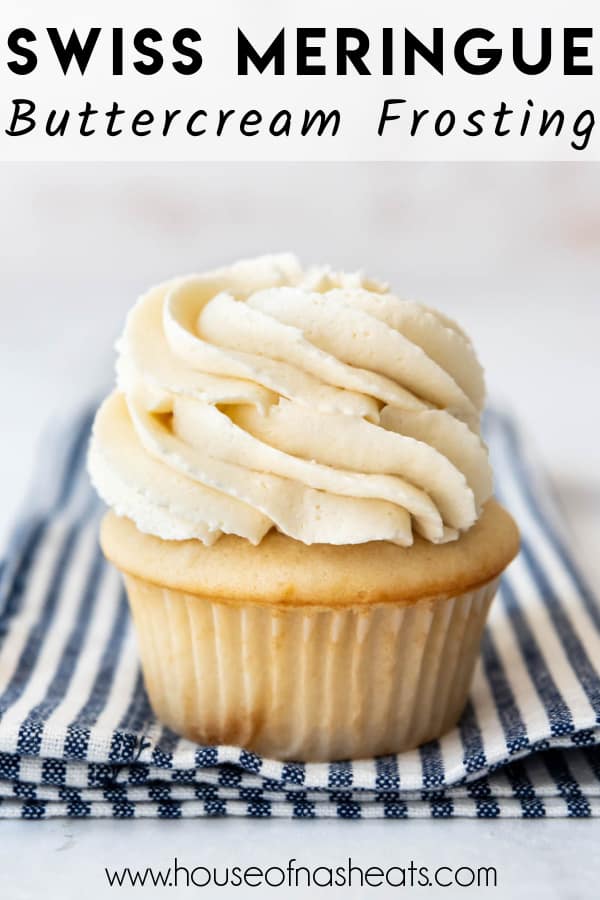
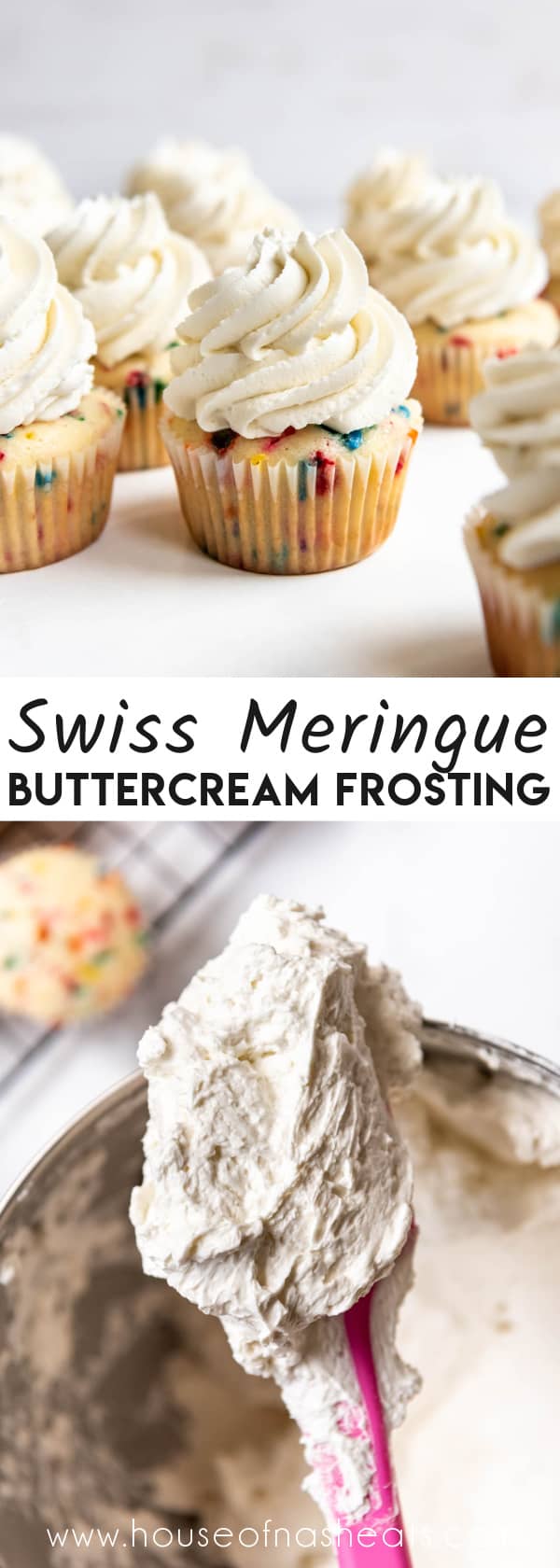
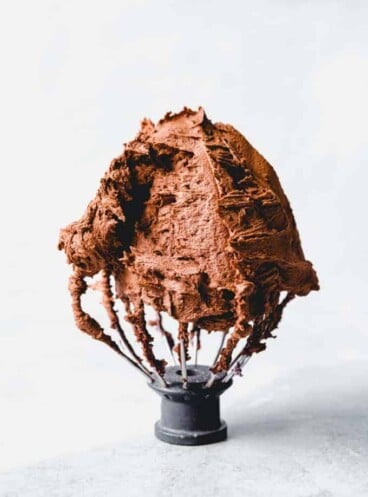
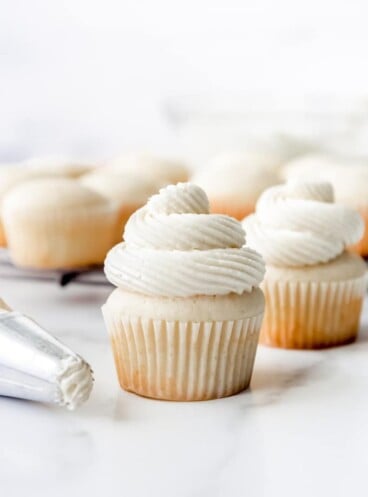
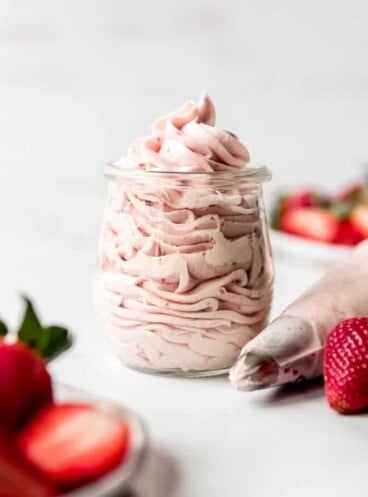

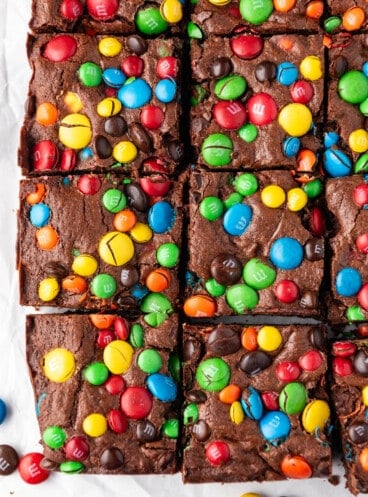
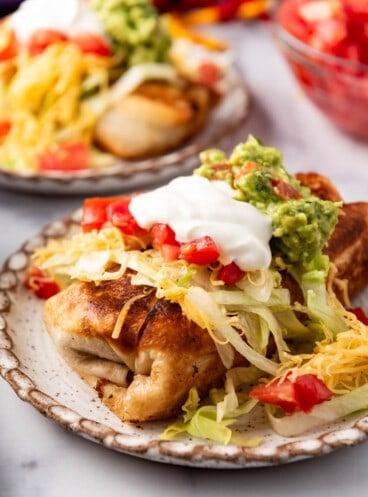



Hello Amy,
Have you ever tried adding puréed strawberries, that have been reduced to remove extra liquid, to the SMBC?
Love your recipes,
Linda from Alaska
Thank you so much, Linda! Yes, I have added up to about 1/4 cup of reduced puree and it works great! Much more than that and the frosting starts to break down a bit. Just make sure to cool the puree completely after reducing so it doesn't melt the butter when you add it. Also, I'm coming to Alaska this summer! Can't wait! We are doing two weeks in the Anchorage/Denali/Homer area at the beginning of August!
This made my special birthday cake even more special. Rich and delicious.
This is my go-to buttercream frosting recipe. It's foolproof!
I'd never made Swiss Meringue Buttercream before but had to give it a try being a meringue lover. I've got to say that it was so good. Your steps answered all my questions and made it easy to do.
THANK YOU! All of your tips and tricks helped me make this perfect the first time! I've always been so intimidated by Swiss buttercream; thank you!!
Love Swiss meringue buttercream! We added a little almond extract to ours for our cupcakes and it was a great choice. Thanks for the recipe, Amy!